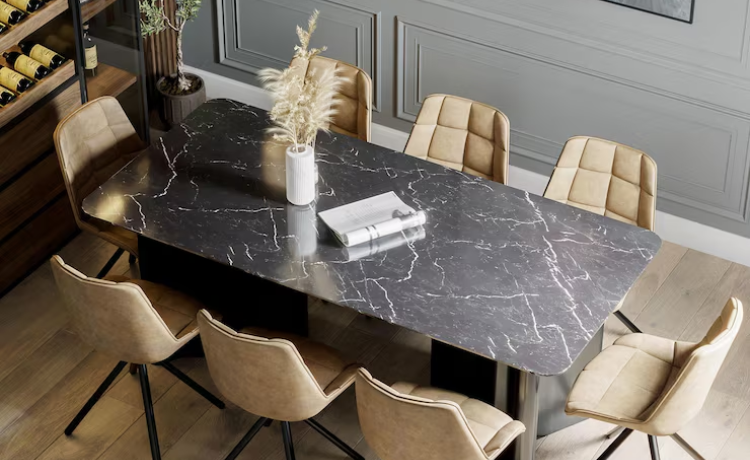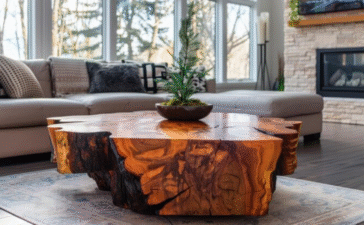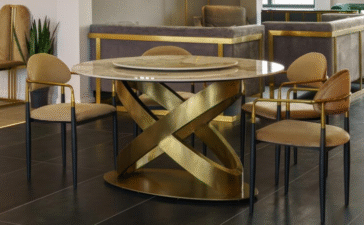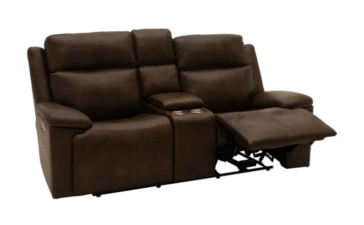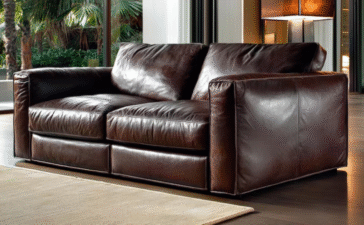Few pieces of furniture command attention quite like a marble dinning table. It acts as a centerpiece that instantly elevates a dining room from functional to extraordinary. For centuries, this natural stone has been associated with opulence and sophistication, gracing the halls of palaces and now finding its way into contemporary homes. Whether you are hosting a formal dinner party or enjoying a quiet morning coffee, a luxury dining table made from marble brings a unique sense of grandeur to the occasion.
However, investing in such a significant piece requires careful consideration. Marble is not just a surface; it is a natural material with distinct characteristics that dictate how it looks, feels, and ages over time. Potential buyers often find themselves weighing the stunning aesthetic against practical concerns like maintenance and durability. A high-quality marble table for dining is an investment that can last a lifetime if chosen and cared for correctly.
This guide explores everything you need to know before making that purchase. We will examine the differences between genuine and faux options, the vast array of styles available, and the realities of living with a natural stone surface. By understanding the nuances of this material, you can confidently select a table that fits both your lifestyle and your design vision.
Understanding the Material
What Makes Marble Ideal for Dining Tables?
Marble is a metamorphic rock formed when limestone is subjected to immense heat and pressure. This natural process creates the characteristic veining that makes every slab unique. When you choose genuine marble for your home, you are bringing in a piece of earth’s history. The cool touch and heavy weight of marble stone material convey a sense of permanence and quality that is difficult to replicate with synthetic alternatives. Beyond its visual appeal, high-quality marble is incredibly heat resistant, making it a practical surface for serving hot dishes, provided you use trivets to protect the finish.
Natural vs. Faux Marble Dinning Tables: What’s the Difference?
Shoppers are often confronted with the choice between faux marble vs real marble. The difference is substantial in both price and performance. Genuine marble is porous and heavy, offering a depth of color and unpredictable veining patterns that artificial materials struggle to mimic. A fake marble dining table is typically made from composite materials, resin, or printed laminates over wood. While faux options are generally more affordable, lighter, and resistant to stains, they lack the cool temperature and unique, organic imperfections that define the luxury of the real stone.
Key Factors to Consider When Buying a Marble Dinning Table
Shape and Size: Finding the Right Fit for Your Space
The shape of your table dictates the flow of your dining room. A round marble dining table is an excellent choice for smaller spaces or square rooms, as the lack of sharp corners allows for easier movement and creates an intimate dining experience. For larger families or those who entertain frequently, a rectangular marble dining table provides ample seating and creates a formal focal point in elongated rooms. If space is tight but you desire the look of stone, a marble table for small space layouts, perhaps in an oval shape, can offer the elegance you want without overwhelming the footprint of the room.
Table Base and Design Options
The base of the table is just as important as the top, both for stability and aesthetics. Because stone is incredibly heavy, the support structure must be robust. A marble dining table pedestal base is a popular choice because it eliminates awkward table legs, offering more legroom for guests. For a mixed-material look, a metal base marble dining table contrasts the soft, organic stone with industrial sleekness. Alternatively, wooden bases can warm up the cool tones of the marble. Modern marble dining table designs often experiment with geometric metal frames or sculptural wood to create a piece that looks like art.
Marble Dinning Table Styles: Which One is Right for You?
Modern Marble Dining Tables
Contemporary interiors thrive on the clean lines and minimalist appeal of a modern marble dining table. These designs often feature thinner slabs of stone, sometimes with a honed or matte finish rather than a high gloss. The focus is on the purity of the material and the simplicity of the form. Contemporary dining tables frequently pair white Carrara or Calacatta marble with sleek black iron or polished chrome to create a sharp, sophisticated visual contrast that fits perfectly in an urban apartment or a modern open-plan home.
Luxury Marble Dining Tables
For those seeking to make a bold statement, a luxury marble dining table is the ultimate choice. These tables often utilize rarer types of marble with dramatic, high-contrast veining, such as the deep blacks of Marquina or the rich golds of Calacatta Gold. High-end marble table designs prioritize thicker slabs and intricate edge detailing, such as beveled or waterfall edges where the stone continues down the side of the table. These pieces are designed to be the undisputed star of the room, exuding wealth and refined taste.
Traditional and Classic Marble Dining Tables
Marble has been a staple in furniture design for ages, making it a natural fit for traditional homes. A classic marble dining table often features an ornate, carved wooden base, perhaps in mahogany or walnut, supporting a polished stone top. The combination of rich wood tones and bright stone creates a timeless look. A vintage marble dining table might feature intricate inlays or a double-pedestal base, appealing to those who appreciate antiques and Old World charm.
Benefits of Owning a Marble Dinning Table
Durability and Longevity
Despite its reputation for being high-maintenance, marble is incredibly strong. A long-lasting marble dining table can survive for generations if it is treated with care. It is a dense stone that resists chipping and cracking under normal use. While it is softer than granite, meaning it can scratch, many owners feel that the patina developed over years of use adds to the character of the piece. Marble table durability is particularly notable in its resistance to heat, unlike wood which can easily scorch.
Elegance and Luxury Appeal
The primary reason homeowners gravitate towards stone is the aesthetic. There is no denying that a luxurious dining table made of marble transforms the atmosphere of a room. The natural brightness of white marble reflects light, making a dining area feel more spacious and airy. Whether your style is rustic, industrial, or glam, marble table elegance acts as a neutral canvas that elevates whatever chairs, tableware, or decor you pair with it.
Ease of Maintenance
The fear of maintenance often scares buyers away, but cleaning is straightforward once you know the rules. Knowing how to clean marble dinning table surfaces properly involves using a pH-neutral cleaner and a soft cloth. Avoiding acidic cleaners like vinegar or lemon juice is crucial. Regular marble table maintenance essentially boils down to wiping up spills immediately to prevent staining and resealing the surface periodically, which is a simple process that takes only a few minutes.
Marble Dining Table Pricing: What to Expect
Budget vs. Luxury Marble Tables: Understanding the Price Range
The cost of marble varies wildly based on the rarity of the stone and the thickness of the slab. An affordable marble dining table typically uses Carrara marble, which is more abundant and has softer, grayer veining. Conversely, luxury marble dining table prices reflect the scarcity of stones like Calacatta or Statuario, which have brighter white backgrounds and more dramatic veining. The complexity of the base and the brand reputation also play significant roles in the final price tag.
How to Choose a Marble Dinning Table Within Your Budget
You do not always have to break the bank to get the look you want. You can find a cheap marble dining table by looking for tops that are marble veneers over a honeycomb aluminum core, which reduces cost and weight while maintaining the look of real stone. Another strategy is to look for marble dining table discounts during major holiday sales or at outlet stores. Floor models can also offer significant savings if you are willing to accept minor imperfections.
Where to Buy Marble Dining Tables
Top Online Retailers for Marble Dining Tables
The digital marketplace offers a vast selection of styles. When you look to buy marble dining table online, retailers like Wayfair, Pottery Barn, West Elm, and CB2 are reliable options with extensive customer reviews. High-end sites like 1stDibs or Perigold offer unmatched luxury options. The best stores for marble dining tables often provide detailed photos of the specific slab you are buying, or at least very clear representations, along with white-glove delivery services to handle the heavy lifting.
In-Store Shopping for Marble Dining Tables
Seeing the stone in person is always preferable given the natural variation of the material. Visiting the best marble dining table stores allows you to touch the surface and inspect the veining. Local furniture showrooms and stone yards are excellent places for shopping for marble dining tables. You can often negotiate on price or customize the table by picking the exact slab of marble you want the manufacturer to use.
Marble Dinning Table Care and Maintenance Tips
How to Protect Your Marble Dining Table from Stains and Scratches
Prevention is the best form of care. You must protect marble dining table surfaces from acidic foods like tomato sauce, wine, and citrus, which can etch the stone and leave dull spots. Using coasters, placemats, and tablecloths is highly recommended during meals. Marble table care tips also include avoiding dragging heavy centerpieces or ceramic dishes across the surface, as dust trapped underneath can act like sandpaper and cause fine scratches.
Sealing Your Marble Dining Table for Long-Term Durability
Marble is porous, meaning liquids can seep into the stone if it is not sealed. Learning how to seal marble dining table tops is a critical skill for any owner. You simply apply a commercial stone sealer with a soft cloth, let it sit for the recommended time, and wipe off the excess. This creates a barrier that gives you more time to wipe up spills before they become permanent stains. Marble table sealing should typically be done once or twice a year depending on how often you use the table.
You should also check: “coastal dining table“
Is a Marble Dinning Table Right for You?
Deciding to bring marble into your home is a balance of head and heart. When asking is marble dining table worth it, consider your lifestyle. If you have young children who are prone to spills and banging utensils, you might need to be vigilant or accept that the table will develop a “lived-in” patina. However, for those who value timeless beauty and natural materials, a marble dining table investment pays off in daily enjoyment and enduring style. It is a piece that commands respect and offers a level of sophistication that few other materials can match.
Frequently Asked Questions
Does marble scratch easily?
Marble is a softer stone compared to granite or quartzite, which means it can be susceptible to scratching. While it is durable enough for daily use, dragging heavy, rough objects like ceramic vases or stoneware plates across the surface can leave marks. Using placemats and felt pads under decor items helps mitigate this risk significantly.
How do I remove a stain from my marble table?
If a stain occurs, the method of removal depends on the substance. Oil-based stains (like grease or milk) often require a poultice made of baking soda and water or a commercial stone cleaner to draw the oil out. Organic stains (like coffee or fruit) can sometimes be lifted with a few drops of ammonia mixed with hydrogen peroxide. Always test any cleaning solution on a small, inconspicuous area first.
Can I put hot pans directly on a marble table?
Marble is naturally heat resistant and typically will not burn or scorch. However, placing a blazing hot pot directly on a cold marble slab can technically cause thermal shock, potentially leading to cracks, though this is rare. The bigger risk is often discoloration of the sealant or scratching from the bottom of the pan. It is always best practice to use a trivet or hot pad.
How often should I seal my marble dining table?
Most experts recommend sealing a marble dinning table every 6 to 12 months. A simple water test can tell you if it is time: pour a small amount of water on the surface. If it beads up, the seal is good. If the water soaks in and darkens the stone within a few minutes, it is time to reseal.
Is marble good for families with kids?
Marble can be a challenging choice for families with young children due to its sensitivity to acidic spills (like juice) and potential for scratching. However, many families enjoy marble by embracing the patina that develops over time, viewing the imperfections as part of the table’s story. If perfection is your goal, you might prefer a honed finish, which hides scratches and etching better than a polished finish.
